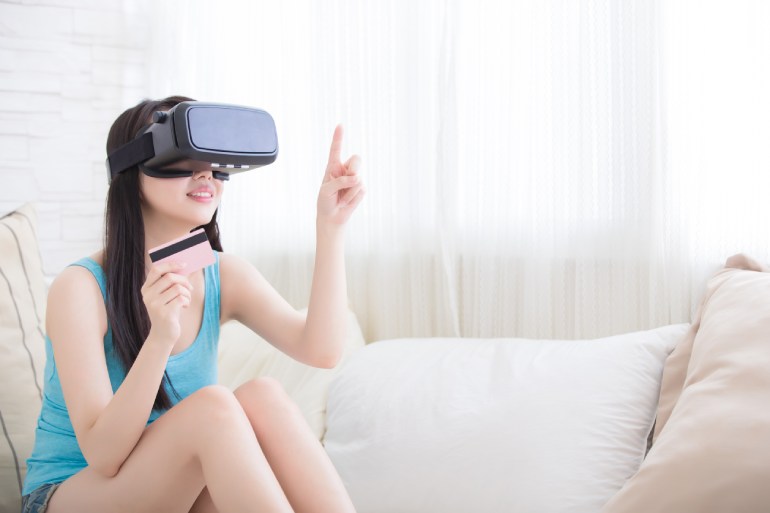 The media hype about VR is currently shifting to practical implementation because the technology is now suitable for the masses and has therefore become commercially relevant – especially for marketing. In addition to VR glasses, there are now some smartphone models that can be converted with simple attachments in such a way that they offer a sufficient degree of immersion to enable virtual reality applications.
The media hype about VR is currently shifting to practical implementation because the technology is now suitable for the masses and has therefore become commercially relevant – especially for marketing. In addition to VR glasses, there are now some smartphone models that can be converted with simple attachments in such a way that they offer a sufficient degree of immersion to enable virtual reality applications.
This brings the topic of augmented reality back into focus: e.g., the user looks at a shop through his smartphone camera and a layer is placed over the image that displays information on current offers. There are tons of application scenarios for VR in marketing since there is hardly a technology group that is not dealing with the topic.
Making experiences tangible in advance
When booking trips, events or outdoor activities, you can often only say after the purchase whether the experience was worth the money. With virtual reality, however, teasers for such kind of purchases can be made possible in advance, which is why the travel industry in particular has been experimenting with virtual reality for some time, providing, e.g., virtual tours of hotels, resorts or cruise ships. Such virtual tours can provide impulses for decision-making before booking a trip. In principle, the same applies to other immaterial experiences, regardless of whether it is a balloon ride, a boat trip or a visit to a music festival. It would be conceivable, for example, to let the user walk across the festival grounds before booking the concert ticket and experience recorded concerts from the last few years in front of the stages.
360° product presentation
Online shops try to compensate for the real experience in the shop with product descriptions that are as precise as possible and photos from different perspectives (360° views) and product films. Some are even already working with AR technologies, such as virtual fittings where items of clothing are placed over the user's images. And instead of rotating the products 360° in a window on the screen, the user can examine them from all sides with VR and place them in different settings. For example, furniture can be placed in differently furnished virtual rooms, car dealerships can allow users to virtually sit (and drive) in different models and try out different functions such as seat colors.
Instead of "just" enabling individual products to be experienced virtually, entire stores could be virtually simulated in which users walk through, "take individual products off the shelf" and have all relevant information displayed directly in the virtual world: price, availability, sizes, additional services, cross and upsells, etc. However, such an additional option should be integrated into the "normal" online shop to enable a cross-channel shopping experience.
Not to mention that location-based communication can be linked particularly well to AR applications: as soon as the user enters a shopping center, for example, they receive an SMS with the request to open the AR application in the shopping center operator's app. If the user now looks through his smartphone camera, layers with the current special offers appear in front of all shops.
Product training & events
Product training in B2B causes high expenses, even if these are usually billed as part of the service. The customer advisor or technician drives/flies to the customer and shows him how to operate a machine on site. For some products, this training could take place virtually in the future. Avatars could also be used to demonstrate the machine in the virtual production hall.
And certainly nothing beats the experience of a live concert, but what if the concert is sold out, the event is too far away, or you just don't have time? For example, users could follow the concert live with their virtual reality glasses, which creates an immersive experience even without physical presence. Theoretically, concert providers can sell unlimited tickets for a concert and open up new target groups.
Of course, what applies to concerts can also be applied to other events that previously required physical presence: musicals, theatre performances, but also sporting events. Tens of thousands of people fit in larger football stadiums, but millions watch some games in front of their home TV that could be considered as a target group for virtual reality stadium visits.
The fact is that virtual reality is gaining in relevance as a marketing channel, but it remains to be seen which types of virtual applications will actually be used in the end. In any case, a conceptual examination of the topic is recommended to see which application scenarios could be relevant for your own business model. Of course, professional 3D graphic designers who can model objects, design textures or create effects are required for this. In addition, it is important to create interfaces between the VR application and the shop system and to check whether it makes sense for the respective application scenarios to track user behavior in the virtual worlds and whether this is also legally and technically feasible.
The question also arises for digital dialogue marketing as to how virtual reality applications can be integrated without causing blatant media breaks or even disruptions to end devices, because VR glasses are an additional device that is probably only used selectively for certain applications. We will see!
By Daniela La Marca


